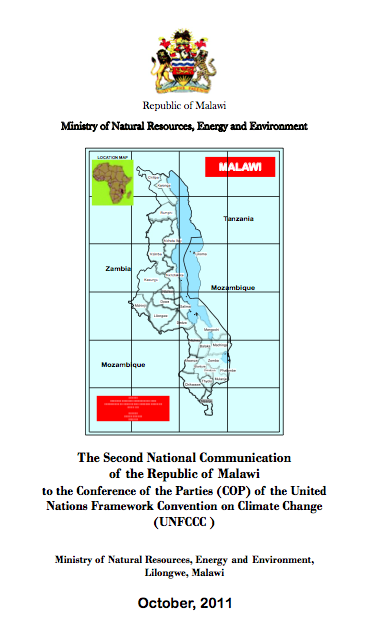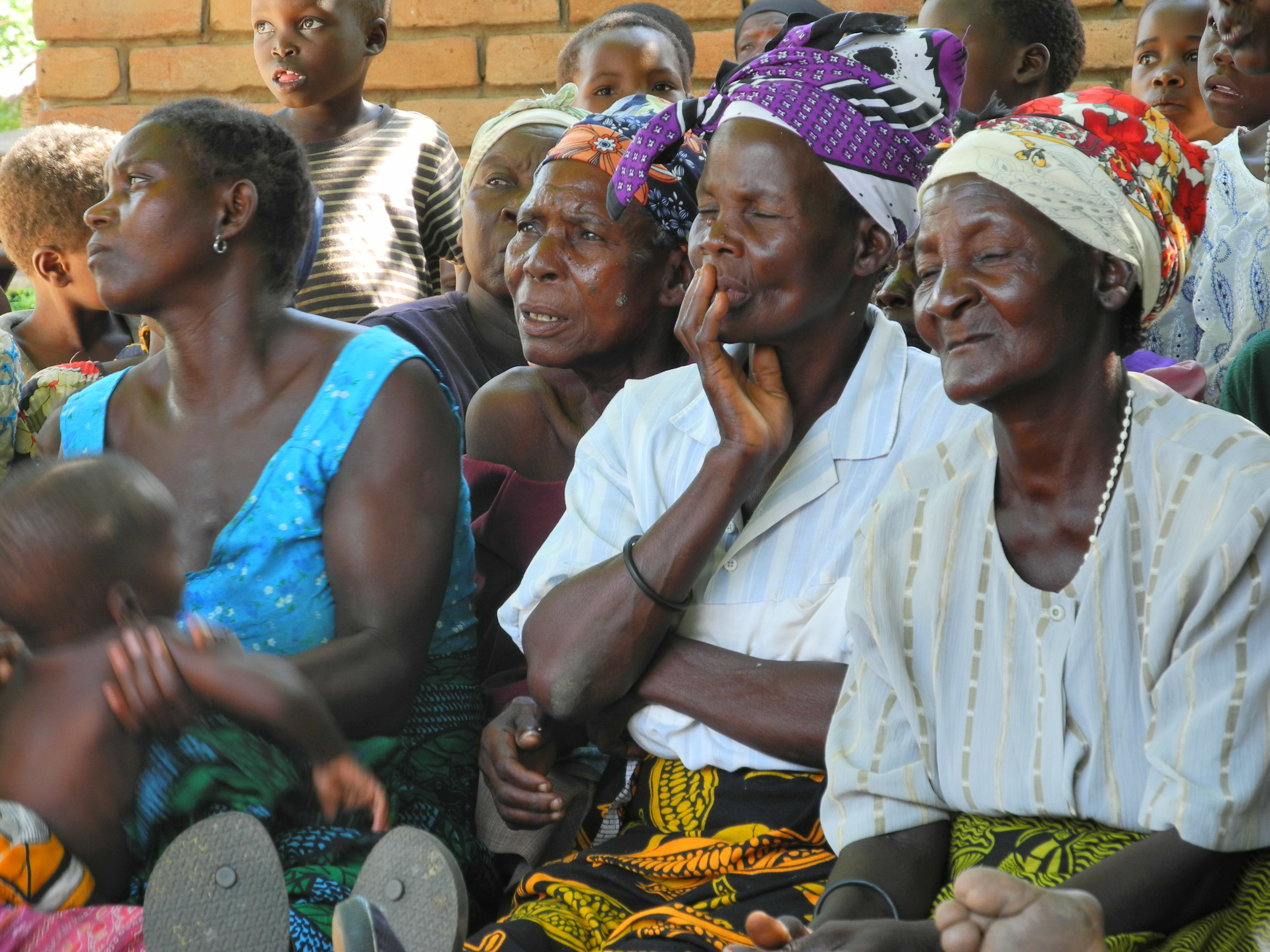Malawi's Second National Communication - October 2011
Project Overview
The creation of a National Communication offers countries the opportunity to contribute with technically sound studies and information that can be used for designing mitigation and adaptation measures, and project proposals that can and will help increase their resilience to the impacts of climate change. Activities generally include: V&A assessments, Greenhouse Gas Inventory preparation, Mitigation Analysis or Education, and awareness raising activities. The ultimate goal is the integration of climate change considerations into relevant social, economic and environmental policies and actions.
Malawi is vulnerable to climate change and extreme weather events and has been experiencing increasing intensity of a variety of climatic hazards, which include intense rainfall, floods, seasonal droughts, multi-year droughts, dry spells, cold spells, strong winds, thunderstorms, landslides, hailstorms, mudslides and heat waves, among many others. The Second National Communication (SNC) has been developed under the scenario of worsening climate change related impacts. The SNC is a comprehensive documentation of measures and strategies, developed through a consultative process, to address threats and challenges posed by negative impacts of climate change and climate variability.
Project Details
Malawi is vulnerable to climate change and extreme weather events (EAD, 1998, 2002a, 2004). The Vulnerability and Adaptation Assessment Report of 2001 (EAD, 2002b) has clearly indicated that Malawi is experiencing a variety of climatic hazards, which include intense rainfall, floods, seasonal droughts, multi-year droughts, dry spells, cold spells, strong winds, thunderstorms, landslides, hailstorms, mudslides and heat waves, among many others.
Currently, the majority of rural communities are experiencing chronic food deficits in many parts of the country on a year-round-basis owing to the effects of floods and droughts. This situation has been compounded by the high prevalence of HIV/AIDS that has created a large number of dependant orphans, and has also adversely impacted on rural household food production systems, as well as the quality of life and sustainable livelihoods.
The increasing prevalence of the recurrent floods and droughts is of major concern to the Government of Malawi because of their far-reaching consequences on food, water, health and energy. Erratic rains have resulted in acute crop failure, despite concerted efforts to improve seasonal weather forecasting at the beginning of the rainy season. Crop failure has resulted in food insecurity and malnutrition, especially among vulnerable rural communities. On the other hand, floods have resulted in the disruption of hydroelectric power generation, water pollution, and increased incidences of diseases, such as malaria, cholera and diarrhea. It is against this background that the government has put in place several policies and strategies to address the adverse impacts of climate change on food, water, health and energy, as articulated in Vision 2020, MPRSP, and the Malawi Economic Growth Strategy (MEGS), among many other documents.
Key Adaptation Needs
The most vulnerable areas to floods are the lakeshore plains and lower Shire valley whereas droughts affect all parts of Malawi. Severe droughts occurred in 1915, 1948, 1992 and 1995, whereas recent floods occurred in 2000 and 2001. People living near riverbanks are the most vulnerable to floods, which results in untimely deaths, disease outbreaks, and the destruction of crops and property. During drought years, many people, especially children and the elderly, suffer from malnutrition and are easily attacked by various types of diseases. Livestock and wild animals are equally adversely affected by droughts.
In most parts of Malawi, rural communities have tried to devise ingenious ways to cope with and adapt to the adverse impacts of extreme weather events, including shifting homes to higher ground, storing grain in local granaries, hunting small animals, gathering and eating wild fruits and vegetables, sinking boreholes, and using traditional medicines to cure various ailments and diseases. However, some of these are not very effective. A list of actual and proposed adaptive measures in the agriculture, water, forestry, fisheries, and wildlife sectors are given in Malawi’s Initial National Communication to the Conference of Parties (COP) of the United Nations Framework Convention on Climate Change (UNFCCC) (EAD, 2002a).
Climate sensitive rain-fed agriculture is the backbone of Malawi’s economy. It is a major contributor to the national gross domestic and foreign exchange earnings. It also supports the livelihoods of over 80% of Malawians who are involved in primary and secondary agricultural activities. Furthermore it is the principal producer of raw material for agro-based industries. As such, Malawi as a nation is very vulnerable to the impacts of climate change.
The Government of Malawi has included climate change, natural resources and environment within priority of priority of the government business as stipulated by the Malawi Growth and Development Strategy. There is however need to mainstream climate change in its sectoral policies and strategies, as well as strengthening of institutional capacity.
The Second National Communication (SNC) has been developed under the scenario of worsening climate change related impacts. The SNC is a comprehensive documentation of measures and strategies, developed through a consultative process, to address threats and challenges posed by negative impacts of climate change and climate variability.
National Circumstances
Malawi is a land-lock country in Southern Africa part of the Great East African Rift Valley bordering Tanzania to the north, Zambia to the east and Mozambique to south and east. Currently the Government is developing an inland port at Nsanje that would eventually open direct access to the sea through the Shire-Zambezi waterway .
According to the National Statistical Office census of 2008, Malawi’s population is about 13 million and growing at the rate of 2.8% per annum, up from 2% growth rate in 1998 census. This dense and growing population, whose livelihood depend on the availability and health of natural resources (NRs), is putting undue stress on NRs through unsustainable exploitation and utilization practices.
Lake Malawi, which stretches across all the three regions of the country, has a major influence on the climate. Other factors affecting Malawi’s Climate are its latitude and altitude. The mean annual rainfall ranges from 725mm to 2500mm and temperature from 12oC to 32oC. The general trend indicates increase in frequency and intensity of climate related extreme events such as floods, hailstorm and strong winds.
Infrastructure plays a critical role in the achievement of sustainable development through improved transport, energy services, information and communication technology, water and sanitation and provision of improved shelter. In recent years, Malawi has experienced damage of buildings, roads and even hydro-power station from climate-related events. As such, infrastructure designs and codes of practice must take cognizance of the threats and challenges of climate related extreme events.
Malawi’s health indicators in terms of infant and maternal mortality, malaria, diarrhoeal diseases, HIV/AIDS and malnutrition are generally poor even under favourable climate scenario. Therefore, under adverse climate scenario the indicators are likely to worsen unless urgent and drastic measures are undertaken to reverse trend.
Women and girls are providers of a number of household essentials such as collection of water, firewood for energy and food. Women and girls are likely to be burdened further in search of water, food and firewood as these resources become scarce under worsened climate scenario.
Malawi’s economy has been growing steadily in recent years. The main stabilizing factors of the economic performance were tobacco earnings and been food self sufficiency both of which depend on favourable climate in addition to supportive government policies and strategies. In its National Adaptation Programmes of Action (NAPA), the Government has clearly spelt out the threats the economic sectors face under adverse climate change scenario, and hence the inclusion of climate change in the Malawi Growth and Development Strategy.
Technology is one of the critical factors necessary to enhance the adaptive capacity of a vulnerable country, sector or community. Malawi undertook its climate change technology transfer needs assessment in 2006 to prioritise technologies that would contribute towards its adaptation and mitigation efforts. Some progress has been made through implementation of projects such as Barrier Removal to Renewable Energy in Malawi (BARREM). An action plan is necessary to ensure that efforts to implementation planned programmes are adhered to.
Key Results and Outputs
- Sustainable development and the integration of climate change concerns into medium- and long-term planning
- Inventories of anthropogenic emissions by sources and removals by sinks of greenhouse gases
- Measures contributing to addressing climate change
- Research and systematic observation
- Climate change impacts, adaptation measures and response strategies
- Education, training and public awareness
The aim of Malawi's Second National Communication is to (i) strengthening the technical and institutional capacities of various public and private sector organizations to acquire skills and competencies in mainstreaming climate change issues into their respective sectoral programmes, policies and strategies, (ii) contributing to global efforts in better understanding the various sources and sinks of greenhouse gases, potential impacts of climate change, and effective response measures to achieve the ultimate goal of UNFCCC of stabilizing greenhouse gas concentrations in the atmosphere to a level that would prevent dangerous anthropogenic interference with the climate system. (iii)
proposing climate change projects aimed at finding solutions to climate change problems that communities can adapt and/or use to mitigate climate change, (iv) enhancing general awareness on climate change and climate change related issues, and (v) strengthening dialogue, information exchange, networking and cooperation among various stakeholders in the public and private sector organizations, including NGOs, and the university, involved in climate change studies in accordance with Article 6 of the UNFCCC.
Further, there is need to intensify the implementation of measures, strategies and programmes that reduce GHG emissions, or provide sinks for CO2, in order to avert the negative impacts of climate change (e.g., poverty, hunger, diseases and land degradation) on vulnerable communities and fragile agro-ecosystems. The recommendations made in this document provide insights into the way forward to address the adverse impacts of climate change, including capacity building at individual and institutional levels, in order to achieve the strategic goals and objectives articulated in the Millennium Development Goals (MDGs) and the MGDS.
Reports and Publications
Assessments and Background Documents
Malawi's Second National Communication - Official Document - October 2011
Monitoring and Evaluation
In 1992, countries joined an international treaty, the United Nations Framework Convention on Climate Change, to cooperatively consider what they could do to limit average global temperature increases and the resulting climate change, and to cope with whatever impacts were, by then, inevitable.
Parties to the Convention must submit national reports on implementation of the Convention to the Conference of the Parties (COP). The required contents of national communications and the timetable for their submission are different for Annex I and non-Annex I Parties. This is in accordance with the principle of "common but differentiated responsibilities" enshrined in the Convention.
The core elements of the national communications for both Annex I and non-Annex I Parties are information on emissions and removals of greenhouse gases (GHGs) and details of the activities a Party has undertaken to implement the Convention. National communications usually contain information on national circumstances, vulnerability assessment, financial resources and transfer of technology, and education, training and public awareness.
Since 1994, governments have invested significant time and resources in the preparation, collection and validation of data on GHG emissions, and the COP has made determined efforts to improve the quality and consistency of the data, which are ensured by established guidelines for reporting. Non-Annex I Parties receive financial and technical assistance in preparing their national communications, facilitated by the UNFCCC secretariat.






